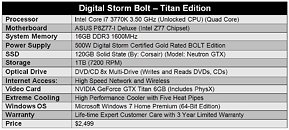Tuesday, February 19th 2013
Digital Storm Bolt Combines Supercomputer Graphics with a Super-Thin Design
Digital Storm, the predominant name in computer system integration and engineering, is excited to announce it will offer a Titan Edition of its award winning Bolt - the slimmest gaming computer ever. The new NVIDIA GTX Titan is the world's fastest graphics card, and utilizes the same technology that powers Oak Ridge National Laboratory's Titan, the world's fastest supercomputer.
The Bolt's unique ventilation system differentiates it from all other small form factor PCs, making it one of the only systems in its class able to handle the powerful GTX Titan. The custom designed chassis features vents near each critical component, large top and rear vents to eliminate any stagnant air inside of the system, and a dedicated air channel created by a slotted side vent to cool the power supply. The design delivers industry leading thermals and ultra-quiet operation.The Titan powered Bolt performed exceptionally when running Steam Big Picture, Valve's popular games distribution platform optimized for big screen TVs. The Bolt's unmatched balance of explosive power and size, just 3.6" wide, make it an ideal console replacement and destined to make the move from the home office or bedroom into the living room.
The Digital Storm Bolt Titan Edition is available now at www.digitalstormonline.com and starts at $2,499.
The Bolt's unique ventilation system differentiates it from all other small form factor PCs, making it one of the only systems in its class able to handle the powerful GTX Titan. The custom designed chassis features vents near each critical component, large top and rear vents to eliminate any stagnant air inside of the system, and a dedicated air channel created by a slotted side vent to cool the power supply. The design delivers industry leading thermals and ultra-quiet operation.The Titan powered Bolt performed exceptionally when running Steam Big Picture, Valve's popular games distribution platform optimized for big screen TVs. The Bolt's unmatched balance of explosive power and size, just 3.6" wide, make it an ideal console replacement and destined to make the move from the home office or bedroom into the living room.
The Digital Storm Bolt Titan Edition is available now at www.digitalstormonline.com and starts at $2,499.


15 Comments on Digital Storm Bolt Combines Supercomputer Graphics with a Super-Thin Design
Edit, it comes with a custom 1U 500W power supply. I'm not sure it'll hold up to any overclocking.
I personally think - with Titan's TDP of 250W, I suppose they can squeeze in the power budget of that PSU if they choose the right CPU + other part combination. But that means as soon as the PSU loses enough capacity (read: right after warranty period ends) the computer WILL asplode (figuratively speaking).
EDIT: OH WAIT it says lifetime warranty. Ah boy, I can already see these units failing en masse && a wave of customer support requests after some period of time.
Not about the Watts? It's simply Amps*Volts=Watts, so technically "Amps on the 12V rails" is all about Watts. ;)
Quality of the power supply has no bearing on Amps, Watts, or Volts. Efficiency, Protection circuitry, and other factors help define quality.
And the last statement is just wrong, because what you are saying is that things like ripple and voltage stability are not indication of quality. Which is nonsense.
Frickity frick frick
But as soon as it gathers enough dust, the precise form of all those fans, holes, and so on will no longer mean sh*t, and the weighting+balance of the fans will also go out of whack. Thus it will start to be noisy.
i.e. it can be silent w/ ample of ventilation. As long as it's clean.
BTW same goes for all parts that are very precisely tuned to have low noise. Dust makes them loud after a certain threshold.
Quality Japanese caps (Nippon Chemi-Con, Nichicon, Rubycon, Panasonic/Matsushita, Sanyo/Suncon, etc.) will last you a decade without degrading even 10% of original spec. Other acceptable brands (in descending order: Taicon, Teapo, Samxon, OST) can in most cases last 5-6 years before showing signs of fatigue. The important thing to realize here is that this doesn't mean a power output reduction. It only means that the delivered power will be of lower quality, to a certain extent. A PSU that was able to output 500W will still be able to deliver that much power even after 10 years (provided it hasn't failed completely).
Qualitatively, a test would show an increase in ripple/noise and a looser transient recovery. Quantitatively, the specific figures would depend on the PSU design. If it's made with enough headroom, the difference may not be worth a mention. Say you have a PSU that outputs 500W with ~40mV @ 12V, ~25mV @ 3.3 and 5V rail of ripple+noise peak-peak, and ~300mV @ 12V dip at adding 250W of load dynamically to it, when it's already delivering 150W. After 10 years, in a PSU with NCC caps and a quality ball-bearing fan, those figures would increase to, say, 70/40/500mV respectively. This is all very much within ATX spec, though a little less desirable than the original numbers. You still can utilize the full 500W that were promised at the beginning.A lifetime warranty refers to the product lifetime, not the buyer's lifetime. It's not unusual for a lifetime warranty to actually cover less than 5 years, so it, in fact, is not the best kind of warranty out there. Also, that kind of warranty usually bears a nasty asterisk at it's end, where it says "only valid under these circumstances: ...."
The best one could hope for is that invoking the warranty 5+ years after purchase results in getting a different system as a replacement, one with similar performance specs.
(And the warranty part cleared up many questions I had before.)